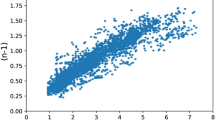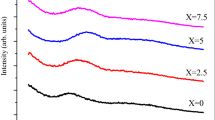Abstract
In the present study, for the first time the machine learning (ML) based refractive index (n) approach is established depends on the density (ρ) parameter of glasses for a dataset of 2000 oxide glasses to predict refractive index of B2O3-CaO-Li2O-Sb2O3 glasses. Density of the investigated glasses varied from 2.56 to 2.97 gm/cm3. The corresponding refractive index was changed from 2.540 to 2.405. The refractive index prediction based on density parameter derived from the density of glasses and constant ‘K’. For all M-L techniques including gradient descent (GD), artificial neural network (ANN), and random forest regression (RFR), the density factor is used as an independent variable and the experimental refractive index as a dependent variable. The data set of 10,000 oxide glass samples was employed to forecast density using a variety of machine learning approaches. In comparison to other models, the Random forest regression (RFR) model fitted the glass data with the highest R2 value of 0.949 for refractive index prediction and 0.925 for density prediction. For both the prediction of density and refractive index, the R2 is controlled to 0.932 and 0.9223, respectively. The highest R2 values for refractive index and density prediction were gained when the tanh activation function was used in an artificial neural network (ANN) with varied activation functions.







Similar content being viewed by others
Data availability
Relevant research data are included in the text of the work.
References
Sun, K.-H.: Calculation of refractive index of a glass as a direct function of its composition. J. Am. Ceram. Soc. 30, 282–287 (1947)
Huang, Y.Y., Sarkar, A., Schultz, P.C.: Relationship between composition, density and refractive index for germania silica glasses. J. Non-Cryst. Solids 27, 29–37 (1978)
Ritland, H.N.: Relation between refractive index and density of a glass at constant temperature. J. Am. Ceram. Soc. 38, 86–88 (1955)
Wen, Z., Curran, J.M., Harbison, S.-A., Wevers, G.: Bayesian mixture modelling for glass refractive index measurement. Sci. Justice 61, 345–355 (2021)
Deng, D.: Machine learning on density and elastic property of oxide glasses driven by large dataset. J. Non-Cryst. Solids 529, 119768 (2020)
Zhang, Y., Li, A., Deng, B., Hughes, K.K.: Data-driven predictive models for chemical durability of oxide glass under different chemical conditions. Npj Mater. Degrad. 4, 1–11 (2020)
Ahmmad, S.K., Jabeen, N., Ahmed, S.T.U., Ahmed, S.A., Rahman, S.: Artificial intelligence density model for oxide glasses. Ceram. Int. 47, 7946–7956 (2021)
Shi, Y., Tandia, A., Deng, B., Elliott, S.R., Bauchy, M.: Revisiting the Makishima-Mackenzie model for predicting the young’s modulus of oxide glasses. Acta Mater. 195, 252–262 (2020)
Cassar, D.R., Santos, G.G., Zanotto, E.D.: Designing optical glasses by machine learning coupled with a genetic algorithm. Ceram. Int. 47, 10555–10564 (2021)
Alsaif, N.A.M., Elsad, R.A., Sadeq, M.S., Rammah, Y.S., Ahmed, E.M., El-Hamalawy, A.A., Shams, M.S.: Antimony (III) oxide-reinforced lithium-calcium borate glasses: preparation and characterization of physical, optical, and γ-ray shielding behavior through experimental and theoretical methods. J. Electr. Mater. 51, 5869–5879 (2022)
Halimah, M.K., Faznny, M.F., Azlan, M.N., Sidek, H.A.A.: Optical basicity and electronic polarizability of zinc borotellurite glass doped La3+ ions. Results Phys. 7, 581–589 (2017)
Somaily, H.H., Algarni, H., Rammah, Y.S., AmaniAlalawi, C., Mutuwong, M.S., Al-Buriahi,: The effects of V2O5/K2O substitution on linear and nonlinear optical properties and the gamma ray shielding performance of TVK glasses. Ceram. Int. 47, 1012–1020 (2021)
El-Mallawany, R., Rammah, Y.S., El-Agawany, F.I., Lima, S.M., Mutuwong, C., Al-Buriahi, M.S.: Evaluation of optical features and ionizing radiation shielding competences of TeO2–Li2O (TL) glasses via Geant4 simulation code and Phy-X/PSD program. Opt. Mater. 108, 110394 (2020)
MohdFudzi, F., Kamari, H.M., AbdLatif, A., Muhammad Noorazlan, A.: Linear optical properties of zinc Borotellurite Glass doped with lanthanum oxide nanoparticles for optoelectronic and photonic application. J. Nanomater. 2017, 1–10 (2017)
Khafagy, A.H., El-Adawy, A.A., Higazy, A.A., El-Rabaie, S., Eid, A.S.: Studies of some mechanical and optical properties of (70–x)TeO2 + 15B2O3 + 15P2O5 + xLi2O glasses. J. Non Cryst. Solids 354, 3152–3158 (2008)
Saffarini, G., Schmitt, H., Shanak, H., Nowoczin, J., Müller, J.: Optical band gap in relation to the average coordination number in Ge-S-Bi thin films. Phys. Status Solidi Basic Res. 239, 251–256 (2003)
McCloy, JC.: Methods for prediction of refractive index in glasses for the infrared. Proc. SPIE 8016, Window and Dome Technologies and Materials XII, 80160G (2011)
Zhao, J., Cole, J.M.: Reconstructing chromatic-dispersion relations and predicting refractive indices using text mining and machine learning. J. Chem. Inf. Model. 62, 2670–2684 (2022)
Hosono, H.: Structural defects and the state of implanted ions in silica glasses implanted with silicon and/or nitrogen ions. Nucl. Instrum. Methods Phys. Res. Sect. B 65, 375–379 (1992)
Çağlar, İ: Gülçin Bilgici Cengiz, Gökhan Bilir, gamma radiation shielding properties of some binary Tellurite glasses. J. Non-Cryst. Solids 574, 121139 (2021)
Tokuda, Y., Fujisawa, M., Ogawa, J., Ueda, Y.: A machine learning approach to the prediction of the dispersion property of oxide glass. AIP Adv. 11, 125127 (2021)
Acknowledgements
The authors express their gratitude to Princess Nourah bint Abdulrahman, University Researchers Supporting Project (Grant No. PNURSP2024R28), Princess Nourah bint Abdulrahman University, Riyadh, Saudi Arabia. The authors extend their appreciation to the Deanship of Scientific Research at Northern Border University, Arar, KSA for funding this research work through the project number “NBU-FFR-2023-0163”.
Author information
Authors and Affiliations
Contributions
Norah A.M. Alsaif: Conceptualization, Methodology, Software, Validation, Investigation, Data Curation, Writing-Review and Editing, Visualization.
Shaik Kareem Ahmmad: Conceptualization, Methodology, Software, Validation, Investigation, Data Curation, Writing-Review and Editing, Visualization, Supervision.
Hanan Al-Ghamdi: Conceptualization, Methodology, Software, Validation, Investigation, Data Curation, Writing-Review and Editing, Visualization.
M.M. Ahmed: Conceptualization, Methodology, Software, Validation, Investigation, Data Curation, Writing-Review and Editing, Visualization.
M.S. Shams: Conceptualization, Investigation, Data Curation, Writing-Review and Editing, Visualization.
Adel M. El-Refaey: Conceptualization, Investigation, Data Curation, Writing-Review and Editing, Visualization.
A.M. Abdelghany: Conceptualization, Methodology, Software, Validation, Investigation, Data Curation, Writing-Review and Editing, Visualization.
Y.S. Rammah: Conceptualization, Methodology, Software, Validation, Investigation, Data Curation, Writing-Review and Editing, Visualization, Supervision.
R.A. Elsad: Conceptualization, Methodology, Software, Validation, Investigation, Data Curation, Writing-Review and Editing, Visualization.
Corresponding author
Ethics declarations
Authors declare that this manuscript is original, has not been published before, and is not currently being considered for publication elsewhere.
Ethical approval
No data carry out of experiments involving human tissue.
Conflict of interest
The authors declare that they have no conflict of interest.
Additional information
Publisher's Note
Springer Nature remains neutral with regard to jurisdictional claims in published maps and institutional affiliations.
Rights and permissions
Springer Nature or its licensor (e.g. a society or other partner) holds exclusive rights to this article under a publishing agreement with the author(s) or other rightsholder(s); author self-archiving of the accepted manuscript version of this article is solely governed by the terms of such publishing agreement and applicable law.
About this article
Cite this article
Al-Ghamdi, H., Alsaif, N.A.M., Ahmmad, S.K. et al. Linear refractive index and density prediction of transparent B2O3-CaO-Li2O glasses reinforced with Sb2O3 utilizing machine learning techniques. J Aust Ceram Soc (2024). https://doi.org/10.1007/s41779-024-01006-w
Received:
Revised:
Accepted:
Published:
DOI: https://doi.org/10.1007/s41779-024-01006-w




